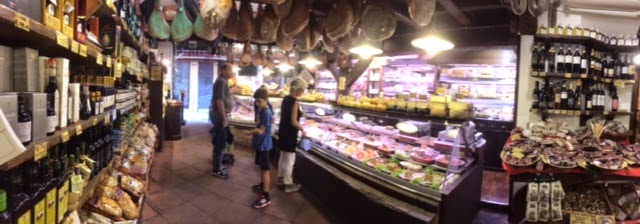 |
| A shop in the market area |
“Watching Italians eat. . .is a form of tourism
the books don't tell you about. They close their
eyes, raise their eyebrows into accent marks,
and make sounds of acute appreciation."
~Barbara Kingsolver
I've had one of those days where I feel as though I've accomplished nothing. After yesterday's five-hour marathon walk around Venezia, my ankles were the size and texture of throw pillows by the time I went to bed last night. It was probably best that I didn't do anything. Still, I feel blobby. I usually walk 3-5 miles each day, so not doing much has taken its toll.
 |
| Cappuccino and brioche |
 |
| Homemade cappuccino a la Bialetti machine |
Everywhere you turn in Bologna, there are "bars." I know I've probably explained this before, but bars are basically coffee bars that have liquor. When I walk out of my apartment building, there are literally four bars within a 30-second walk. I only go to one, Bar Santo Stefano, because the owner was my first friend in Bologna. Between my apartment and the Piazza Santo Stefano, there are an additional four of which I'm aware. Other than BSS, the only other one I really like is Bar 44 which is at 44 Via Santo STefano. The owner there is also very nice and has become a friend.
One thing that drives me batty—but it is the way they do things—is that some bars charge a different amount if you sit at a table rather than stand at the bar. Ok, you probably think, they're charging for table service. In most cases, you have to carry your own drink/pastry to your seat. For that privilege, you get to pay at least double. The worst I ever saw was in Venice when Mike and I were there in 2010. We went to a bar, ordered the cappuccino and pastry, and sat down. When we went to pay, what would have cost us 5 euro had we stood at the bar, cost us 18 euro because we sat.
 |
| Honking big espresso machine |
(Side note: There is no law requiring bars or restaurants to throw out bread or chips or whatever they've taken from your table. I've seen waiters take a basket of bread that people have eaten from and place it on another table. I skip bread and such at restaurants.)
 |
| Working tableside |
 |
| Caramelle prosciutto e asparagi |
Probably the best pasta I had out was at a little place, Trattoria dal Bissanott, on a side street away from the tourist area. I ordered Caramelle prosciutto e asparagi (above), a handmade pasta filled with cheese. It had a very light cream sauce with prosciutto and asparagus pieces in it. It gets its name (caramelle) from the fact that they fill the dough and twist it to look like little caramels. It was delightful.
 |
| Plain, good salad |
I also had a good salad one afternoon when I just didn't want pasta anymore. The mixed greens (above) had a light dressing of just oil and balsamic vinegar (They do not have a million different dressings in Italy. If you don't like oil and vinegar, I'm not sure what you do.). Topped with aged parmigiano and pancetta (Italian bacon), it was wonderful.
 |
| True Parmigiano-Reggiano cheese wheels |
 |
| Different cheese cut |
To make true Parmigiano-Reggiano (Parmesan to Americans), the cheesemakers have strict formulas. The two basic ingredients are whey and salt, and the cheese ages about 12-24 months (and, you can tell a difference). Once it reaches maturity, a master "grader" tests it, and if it passes, the cheese gets a seal.
Interestingly, only cheese made in this specific region of Italy is actually Parmigiano-Reggiano, and the name is trademarked and protected by both the Italian and European Union governing bodies. Any imitation cheese made elsewhere may not use the name. In other words, if a store anywhere in the EU sells what we call Kraft Parmesan Cheese, the label here reads, Parmello.
 |
| Tiramisu |
 |
| Cannoli |
 |
| Crostatine |
Of course, I wouldn't turn down gelato or anything that had Nutella (below) in it, either.


No comments:
Post a Comment